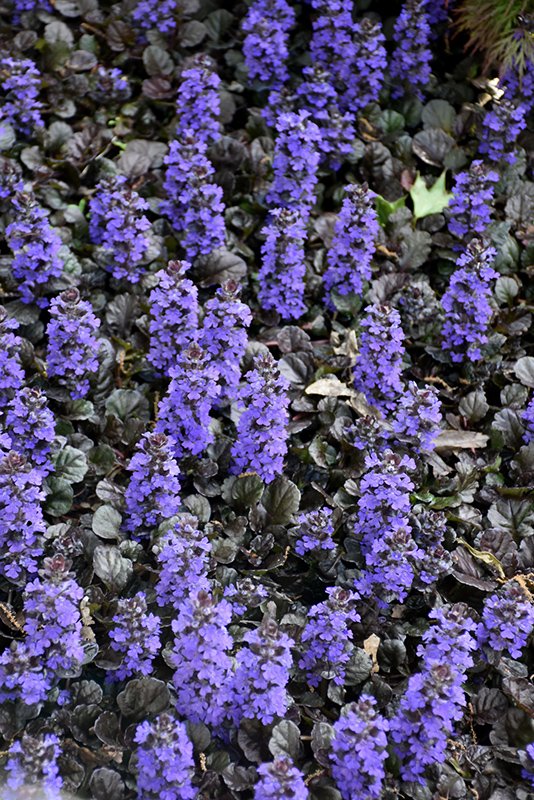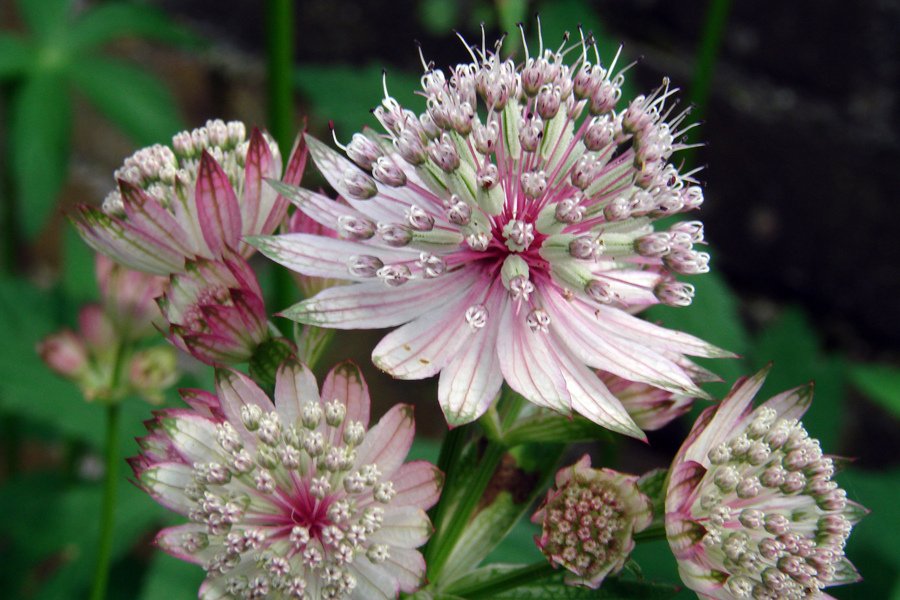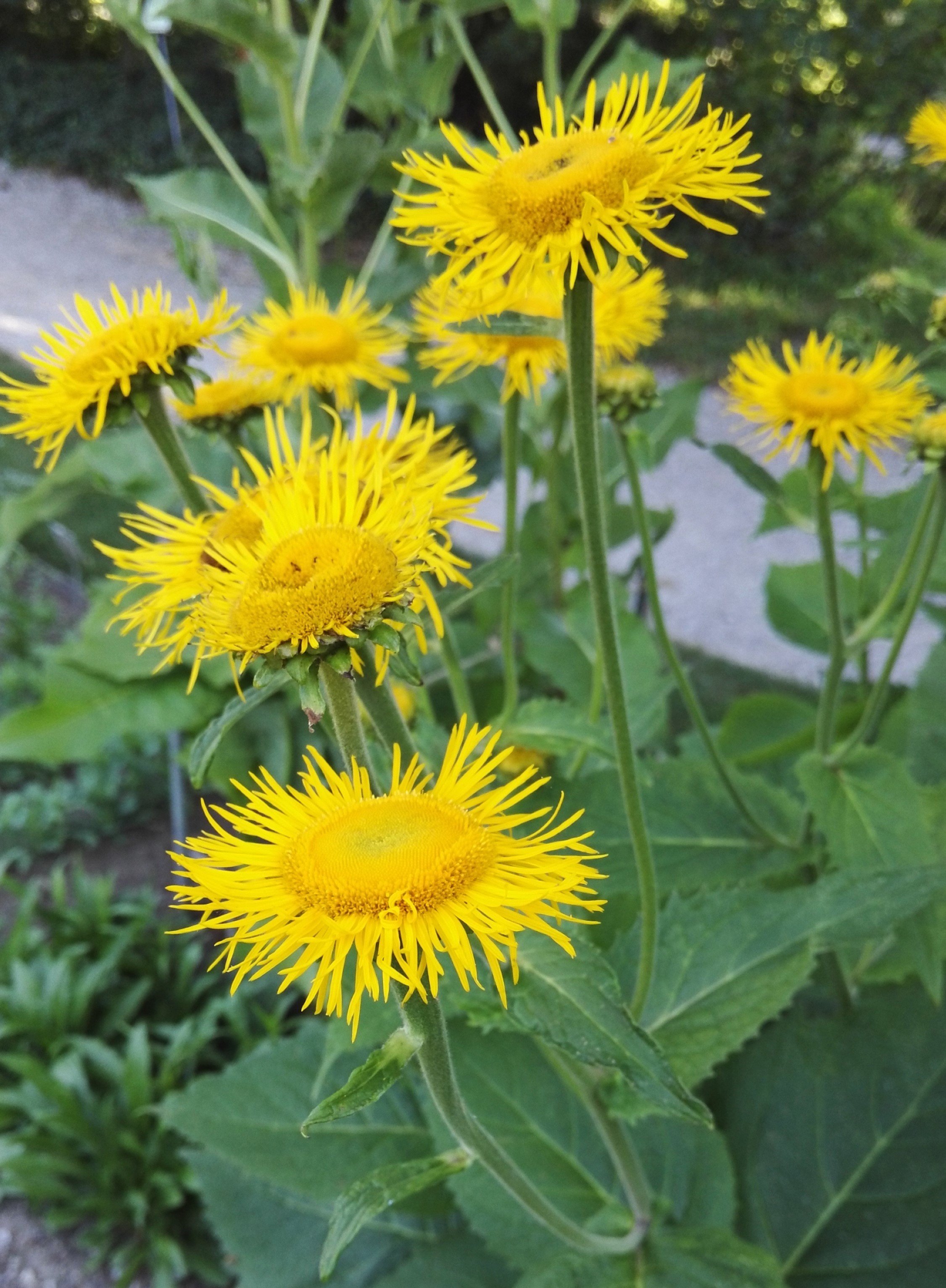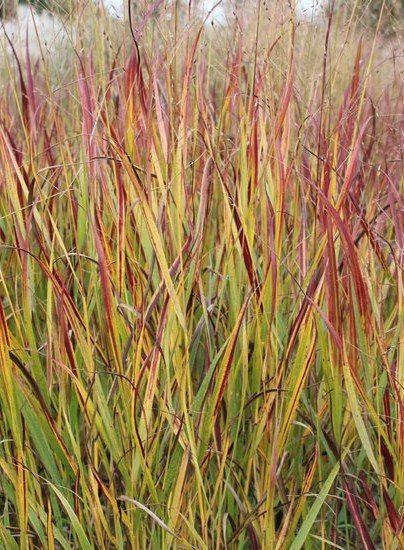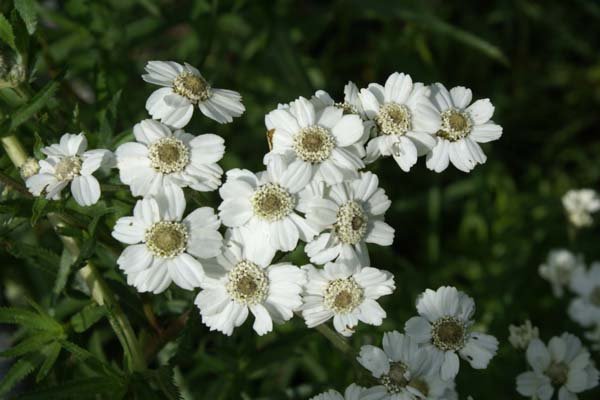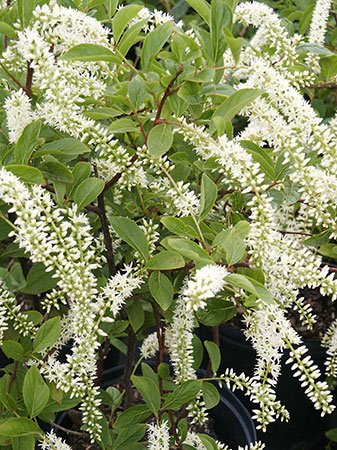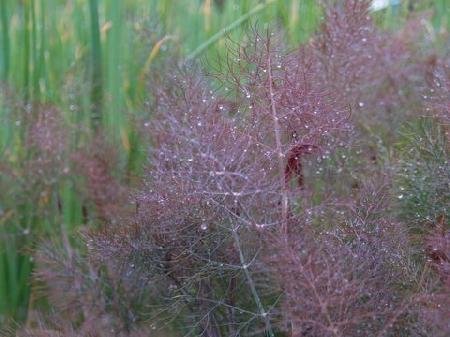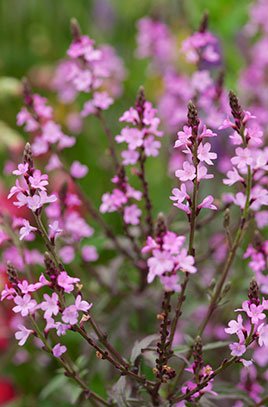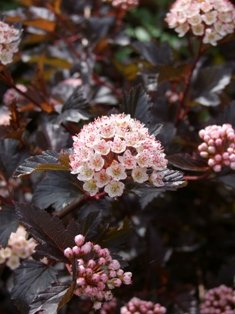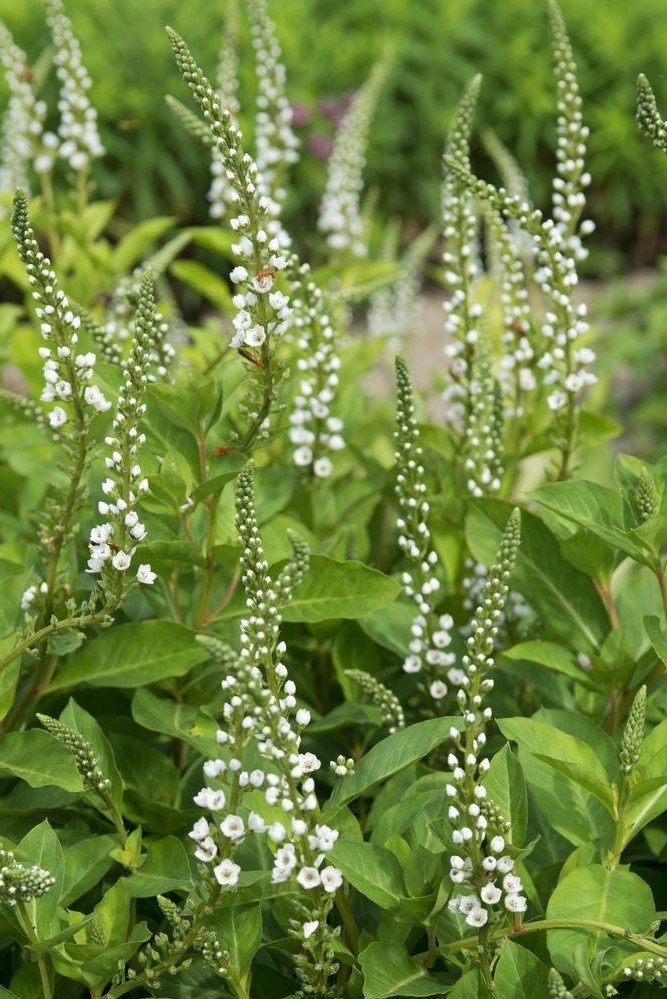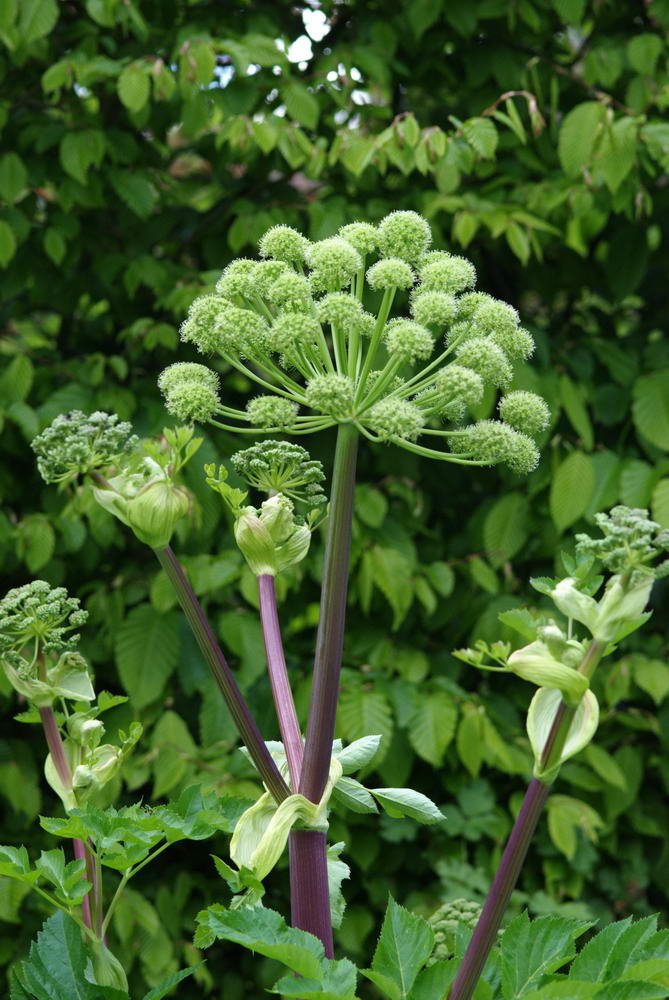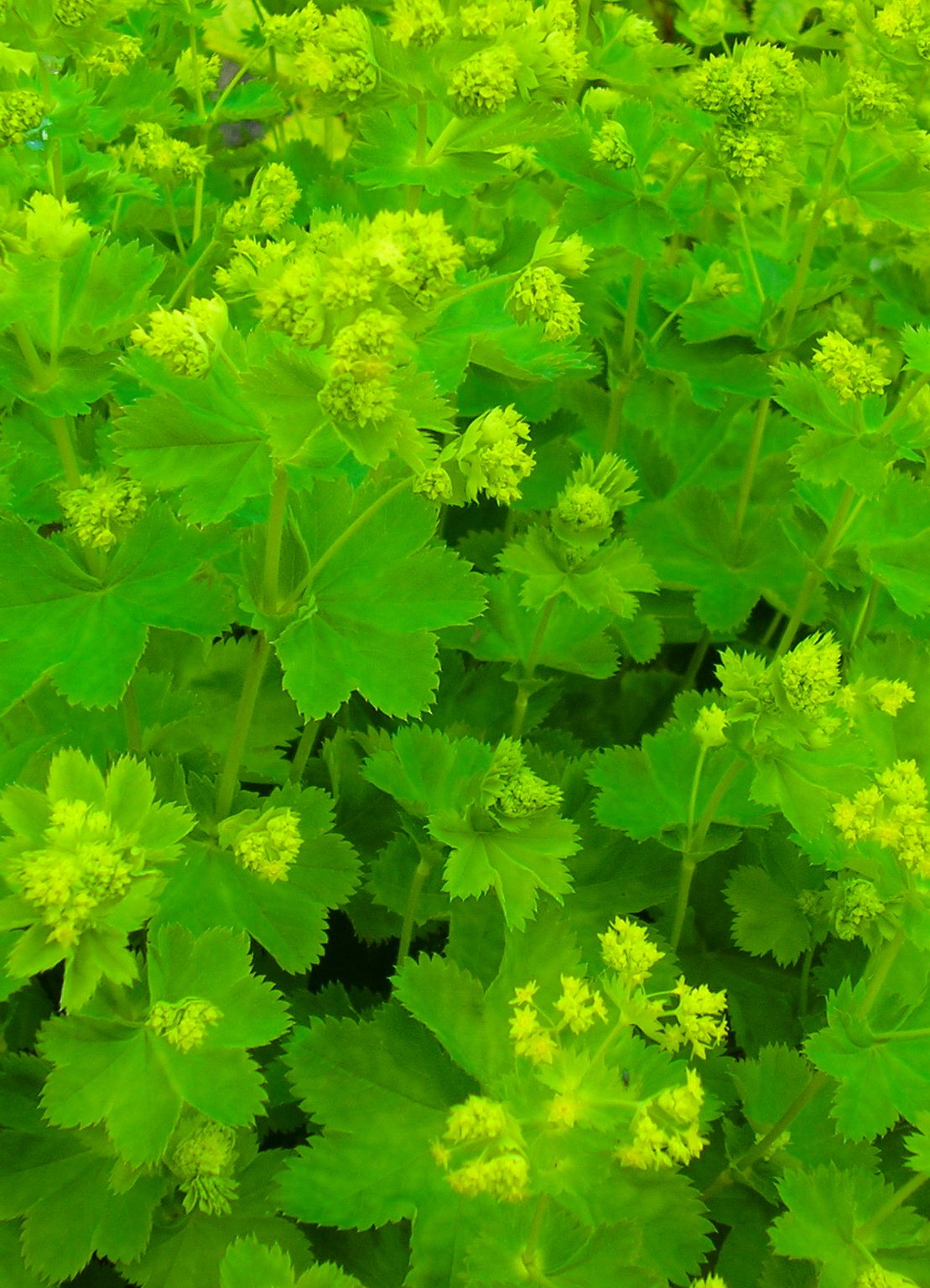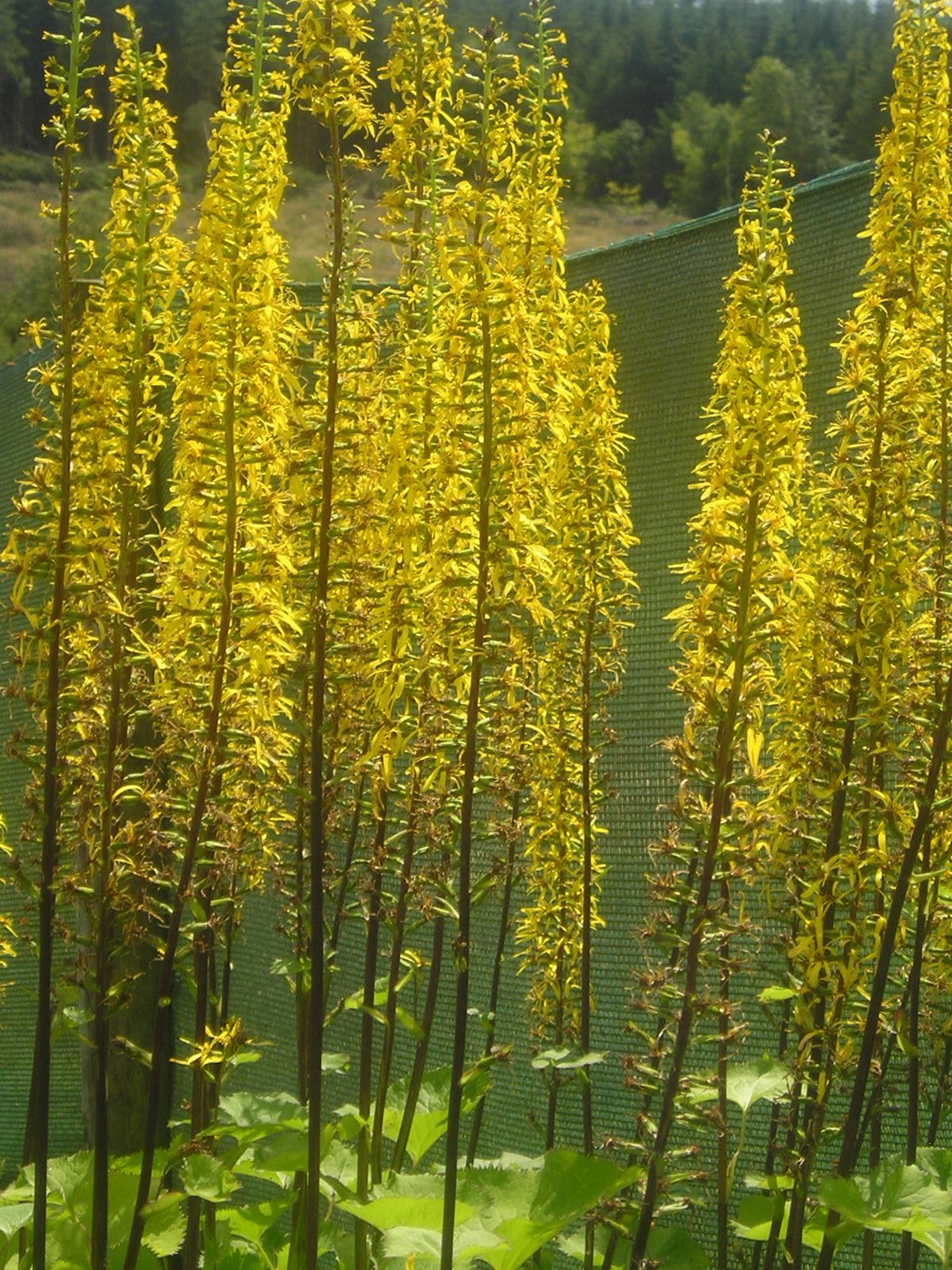Including daisies in the garden
Classics in the garden and in the floristry world, valued for their simple flowers. Many argue a garden and a bouquet are incomplete without a floral element in this distinct shape. Whatever your opinion is on that argument daisy type flowers have been around for a long time and they make us feel summery. I think that there is a place for them in any and every type of garden.
We grow many plants with daisy type flowers and in this piece I’ll talk about Leucanthemum x superbum, Anthemis, Coreopsis, Rudbeckia, Leucanthemella and Erigeron. I have a couple of nice planting plants for daisy type plants that I will detail and I’ll mention a couple for different areas of the garden and the latest blooming varieties that we grow at Caherhurley Nursery of the families mentioned above.
Daisy types are grown for their flowers. The foliage is not first class. In some cases it’s the type of foliage that you want to plant something with to disguise it. That’s no problem, and gives a flowering area of the garden longer lasting interest, as foliage lasts much longer than flowers.
The first plant variety I’m going to talk about is Anthemis tinctoria ‘Sauce Hollandaise’. This perennial is long flowering, earning it a place amongst our favorites here on the nursery. It grows to 60cm and has pale yellow with a darker yellow centre from June to August about a mound of divided foliage. Like all Anthemis it can get a little leggy, and the basal foliage isn’t the prettiest so in this planting we will include Ruta graveolens ‘Jackmans Blue’ which likes the same conditions of well-drained soil and sun. This plant can grow to 60cm also. If pruned annually in spring the leaves will have the best colour, with a slight blue tinge to the leaves, amplifying the yellow of the Anthemis flowers. To set the two off even better we include a third plant, Geranium ‘Blue Cloud’. The gentle, absent-minded beauty of the pale blue Geranium flowers weaving their way through the dense looking foliage of the Ruta and the far more solid Anthemis is a pleasing contrast. Again, the contrast between the blue and the yellow help each other to look their best. Alongside or behind these the spikes of Salvia nemerosa ‘Caradonna’, flowering from June to September with masses of vivid indigo-blue flowers held on dark stems in upright spikes. The spikes give a superb contrast to the disks of the sun worshipping Anthemis and the softly rounded cup of the Geranium. A lovely little planting combination. A planting such as this can be repeated in a bed in a certain size, say a meter squared or it can be as big a planting combination as you have space for. The more plants you include, the greater impact it will have. It feels bold to make a bed with just a small combination of varieties but the effect is striking.
Leucanthemum x superbum ‘Beauté Nivelloise’ or Leucanthemum x superbum ‘Beethoven’ would either work well in the following planting. The choice between them is personal- do you prefer the classic daisy petals of the Beethoven or the shaggy petals of Beauté Nivelloise? Either Leucanthemum will grow to at least 60cm and flower from June to August. The flowers of both are large, with white petals with yellow centers but the foliage is, again, not very interesting so we’re going to put a plant with strong foliage in front. Planted with the Leucanthemum we will have Rudbeckia tribola ‘Prairie Glow’. This Rudbeckia grows to 100cm and has golden red-brown flowers with a brown cone centre. They bloom from June-September.
In front we put in a few Bergenia ‘Ballawley’. This large leaved Bergenia has green leaves in the summer that turn purple-red in the winter. The leaves can grow at an upright angle, giving us the interesting view of both the top and the bottom side of the leaf. The veins on the base are striking on such big, bold leaves, particularly when they start to tint purple-red. This plant is a great foliage plant and the long interest of the foliage adds to its value. It has flowers too, that make great cut flowers. They can look otherworldly next to daisies. The flowers are pink on tall pink-red stems in March to May (before the Leucanthemum and Rudbeckia giving the planting a longer over all flowering period).
Finally, as a back ground (we are assuming a bed that has a fence or wall at the back) we will have another plant with strong foliage. Ageratina altissima ‘Chocolate’ has chocolate brown leaves and stems and grows to 120cm tall. It has clusters of fluffy white flowers from July to September. It is a clump forming perennial so be sure to give it space. The chocolate brown leaves are a good back ground for the white of the Leucanthemum and make the Rudbeckias colours look luxurious. This planting is striking and requires more space than the first idea.
Some plants with daisy flowers have lovely foliage and form- Coreopsis is one of these. It grows in a nice mound, and pretty leaves, on some varieties they are almost feathery on others there are more star like divided leaves. They flower usually from June to August but can keep going to late September. They look good at the front of a bed or border and grow up to 40 – 50cm. We grow several varieties of Coreopsis and feel they are a great addition to the garden.
For a rockery area the little but mighty Erigeron karvinskianus is a great choice. It self seeds, has a long flowering period and can grow in most places. It has masses of classic daisy flowers in white and pink. It can flower up to nine months of the year! Flower stems are up to 20cm tall.
Another Erigeron worth mentioning is the ‘White Quakeress’. This lovely plant has masses of white daisy type flowers with yellow centers. It grows to 30cm and flowers from June to September or often longer. It is clump forming, like all Erigerons and looks lovely in a border.
For a later flowering daisy type Leucanthemella serotina ‘Herbststern’ is a good choice. This robust, vigorous erect perennial has stems to 150cm. The large 7cm wide, daisy type flowers with yellow centre can be seen from September to October. This variety has wider petals (white ray florets) than Leucanthemella serotina. Like all daisy type flowers this autumn ox eye daisy likes a well-drained soil in the sun.
Early flowering plants for February and March
Primula ‘Elizabeth Browning’
Winter is starting to get a bit dreary and we’re itching to get back into the garden. Already strolling around, looking at beds to see what is starting to come up and in some cases, being a little surprised by how big certain plants seem to have gotten based on the larger area than last year that their shoots are coming up in. Some digging out and moving plants around may be in the relatively near future. For now though, with the days getting brighter and longer talk is turning to what the best plants for some early flowers in the garden are. A spring border (or spring flowers included in a border), and early flowering perennials planted under and around trees and shrubs bring a welcome and needed infusion of beauty, affirmation of life and joyful colour.
The quiet, sleeping peace of winter is beautiful in its own pure and elemental way but these early spring flowers really do lift the spirits with their hints of what is to come over the rest of the season.
In February, just around the corner now as I write in mid January, we await Primula ‘Elisabeth Browning’ and Primula vulgaris. Some people hear ‘Primula’ and assume really early flowering and this is true for some varieties but actually a lot of varieties, for example the candelabra types amongst others, bloom around midsummer. Have a look at the flowering times of any Primulas you buy if you’re planning on an early blooming plantings.
Primula ‘Elisabeth Browning’ has pale creamy white flowers. Smaller and more delicate than many primula flowers and absolutely loads of them. A really sweet gentle first bloomer to ease us into the season. Primula vulgaris is native to Ireland, one of our wild flowers. It is a protected species and cannot be picked or dug up in the wild. I’m sure most everyone in Ireland is familiar with its creamy yellow flowers that are an important source of food to bumble bees waking up from hibernation. Both of these Primula like moist, well-drained soil in partial shade. Elisabeth Browning grows to 15cm, very dinky, and vulgaris to 20cm.
February flies by, with more birdsong, shoots , leaves and buds appearing daily. The palette of March perennials expands to include some deep blues and reds. Some of our favourite March flowers include: Saxifraga ‘Red Pixie’, Pulmonaria ‘Blue Ensign’, Primula veris, Cardamine pratensis and Anenome nemerosa ‘Robinsoniana’. A variety in habitat, form and colour is now available. We can choose to have early flowering plants in many parts of the garden or even in pots.
Saxifraga ‘Red Pixie’ is a small plant with toothed leaves holding its magenta-red flowers proudly on stems up to 10cm high. It flowers from March to June and is an out standing little plant. It does well on the edge of a border, in a rockery that doesn’t totally dry out and in pots. A group planting gives a good visual impact.
For slightly damper ground Cardamine pratensis (one of our native Irish plants) with its light purple-pink flowers or Primula veris (cowslip, another native Irish wild flower) with its distinctive drooping yellow bell shaped flowers held in whorls are excellent choices. Its lovely to see the flowers we knew from childhood in our gardens. So many visitors to the nursery are delighted to see Primula veris, remembering how it grew in loads of places when they were children but its not as common in the wild anymore. How nice, and beneficial to nature, to be able to preserve our native Irish wild flowers in our gardens. Cardamine pratensis grows up to 40cm and Primula veris to 20cm. Both bloom from March to May.
Pulmonaria ‘Blue Ensign’ and Anenome nemerosa ‘Robinsoniana’, both with blue flowers, will grow happily in a woodland garden or in a border. The ‘Blue Ensign’ has startlingly indigo bell shaped flowers and the distinctive soft feeling spotted lungwort leaves. As a child I was so enamoured of Pulmonaria, its soft spotty leaves, the gentle arches of the flower bearing stems and the jolly, bright coloured bell shaped flowers that I had it in a pot on my bedroom window sill. It can grow in containers with careful watering. Anenome nemerosa ‘Robinsoniana’ has almost electric blue star shaped flowers held above its divided leaves and will happily naturalise in partial shade, forming a carpet.
Jasminum nudiflorum, a winter flowering Jasmine grows to 1.5m and bears yellow flowers on bare stems in winter or early spring. It can be grown with support or as ground cover. The tough flowers will come even in very cold temperatures. Last but not least, a real gem for early interest in the garden is Salix gracilistyla ‘Mount Aso’. This shrub grows to 1.5m and has beautiful fuzzy pink and silver upright catkins in late winter to early spring on pinkish bare wood. They look fantastic in the pale wintery light.
Foliage in the garden
Foliage in the garden- how to use it to the best effect, simply and with impact.
When we choose our plants it’s easy to look only at the flowers and choose what we want based on flowers alone- even though they might only flower for a short part of the year. We always say to look at the foliage as well. This is the part of the plant that you will see for longer and with foliage you can create strong visual impact, texture and interest in the garden easily.
‘When selecting your plants take a good look at the foliage. Notice how it grows, i.e. does it grow close to the ground like Ajuja reptans ‘Black Scallop’? Form a mound like Geranium ‘Brookside’ or Astrantia Berendien Stam’? Is it tall with shiny leaves like Telekia speciosa? Perhaps it is a spiky transparent such as Panicum virgatum ‘Rotstrahlbusch’. Choosing plants with different forms, shapes and textures of foliage creates a natural looking garden that has great visual impact.
Focal points can be created and included using foliage, as well as using flowering plants. Think again about colour and shape. Colour interest can be included by using plants with dark or silvery foliage as well as greens. The unmistakable silvery fern-like leaves of some Achilleas for example or the dense matt grey and interestingly scented clumps of Helichrysum ‘Schwefellicht’. The dark purple leaves and serious structure of Verbena officinalis grandiflora ‘Bampton’ make it a lovely example of a mid-sized (up to 80cm) plant that has dark leaves, a strong structure and branching growth that makes it a handy translucent. Excellent in so many areas of the garden. Physocarpus opulifolius ‘Diablo’ grows up to 250cm and its dark purple leaves stay dark all summer. Every garden should have one! A great canvas to plant contrasting colour in front of. Yellows will really stand out in front of the dark leaves, or blues, pinks or purples will complement the colour of the foliage nicely.
Some foliage changes colour in a striking way, such as Lysimachia ‘Candela’. The light green, luscious foliage turns a vibrant fiery red in the autumn. The pretty white flowers bring summer interest and the change of colour in the foliage continues the interest of the plant well into late autumn making it a valuable addition to the garden. Planted in a group of three to seven creates a strong impact, without looking unnatural. Any plant that gives interest for this long is great value for money and well worth including. For something larger, that gives interest for a long time too with a vibrant colour in the foliage ‘Itea virginiana ‘Henry’s Garnet’ is a lovely example. While known mostly for its profusion of white flowers that carpet the shrub in mid Spring to early Summer, its foliage is wonderful turning to purples and reds in the Autumn and into early Winter. It grows up to 120cm. A good shrub to mix in with perennials or to plant in a group for a big impact area.
The tall feathery bronze coloured fronds of Foeniculum vulgare ‘Purpureum’ or the statuesque Angelica archangelica are both examples of foliage focal points for height. Think about texture and shape as well as size. Lychnis coronaria ‘Atrosanguinea’ has soft grey tactile leaves and its foliage grows low. It’s difficult to walk past without touching the velvety leaves. Alchemilla with its gentle scalloped leaves that enchantingly hold a pearl of rainwater in the centre after a shower is a lovely addition to the garden. They grow in such a natural way, around and between other plants and garden features that they lend a natural, soft feel to any garden they are included in.
Size of the leaves is another consideration. Place plants with a variety of size and shape of leaves close together to give the best effect. Remember to plant in groups of three to seven depending on how much space you have. Group plantings of plants with large leaves such as Ligularia ‘Zepter’ give an exotic, jungle-like feeling. Using a hardy plant like this is a cheap and fast way to create this exotic look- the plants will get bigger each year and there is no need to bring them inside or cover them in the winter. The small dense leaves of Thymus pulegioides ‘Creeping Mauve’ make a tumbling mound of shiny green, they will cascade over rockeries or stones and will grow around the base of taller plants.
When deciding what to put where consider putting contrasting foliage close together so that each is highlighted but not so contrasting that it gives a stark effect. Include different sizes and shapes of plants and different sizes and shapes of leaves. Be sure to play with colour and texture. The effects you can achieve with foliage are stunning and satisfying, bringing a lovely depth to your plantings.
All of the varieties mentioned in the article are available to buy now in our online shop or here on our nursery.
Growing cut flowers
Growing cut flowers best varieties lots of unusual flowers ecofriendly bouquets
We are getting a lot of questions about which plants to choose for a bed for cut flowers at the moment on the nursery, so we decided that would be a good topic for a post.
We are really happy to get these questions, we are always happy when people have an idea in mind for their garden and want our advice on that. Growing your own cut flowers is so much better than buying bunches from the supermarket or filling station. No chemicals, more variety. Your bunches of flowers will be unique and exactly what you want them to be. If you don’t have space or time to grow your own flowers try to buy your cut flowers from a small Irish grower at your local farmers market or café.
If you are making a bed for cut flowers a sunny spot, sheltered from the wind is best. Using certified organic, Irish grown, hardy perennials will be the best for your garden and the environment as well as ensuring that your garden grows better and more bountiful year on year as a garden should. Annuals may have their places at times, to be dotted in odd places to add a bit of extra colour, but hardy perennials should form the bones of your cut flower bed. They will often have a second flowering if tended to, and have a longer flowering period and longer lasting blooms than annuals. Perennials come back bigger each year, so the cost and work of planting again each year is avoided. With a little planning and fore thought you can create a cut flower bed for even as little as €100. This in our nursery will give you 24 plants (plants are usually €5 each but we have a special on site deal of any six plants for €25 when you pick the plants out yourself). Plus, for every €50 you spend on the nursery you get a free plant from the freebie table, these change regularly by the way. So for your €100 you would get 26 plants to start a cut flower bed. You should plant 5 plants per square metre, so this would give you a cut flower bed of just over 5 x 1m square blocks.
Its tempting to grab one of every variety that you love but you need to consider how many flowers an individual plant will bear, and how you want your bed to look after you’ve taken all the cut flowers that you want. I find that cut flowers that I take from the garden last easily two weeks in the house, even in the warmer kitchen. The flowers in the cooler bathroom last three weeks at least. The lifespan of the bunches of flowers that you cut for the house means that you won’t have to cut every flower from your bed, and you’ll be able to enjoy the bed in the garden for itself as a beautiful flower bed that you planned as well as having cut flowers from the garden in as many rooms of the house as you like.
So back to our bed and our example of 26 plants. Some will give us lots of flowers and will clump out quickly, for example Rudbeckias and Symphyotrichums. Others give less blooms per plant and so we would need more for a bed that will be used to harvest cut flowers from.
I have sketched out two quick examples- one for €100 as a starter cut flower bed and another €100 bed, together they will make a comprehensive all summer and well into the late autumn cut flower bed with variations in shapes, textures and colours. We use our basic rule of 5 plants per meter squared here.
Bed #1; Rudbeckia x 3
Symphyotrichum x 2
Achillea x 3
Chrysanthemum x 3
Monarda x 3
Nepeta x 3
Polemonium x 3
Solidago x 1
Thallictrum x 3
plus 2 x choices from the current freebie table during your visit.
If you have some more space I’ve put together a suggested list to add some more variety to your cut flowers- this list is for the same amount of space (and the same cost as above. Each takes up 5 x 1m squared and each costs €100).
Bed #2; Amsonia x 5
Catanache x 5
Geum x 3
Eryngium x 3
Helenium x 5
Artemisia lactiflora x 3
plus 2 x choices from the current freebie table during your visit.
You may notice that the flowers in the above lists have a wide variety of shapes of flowers and foliage and different flowering times. This adds interest and variety to the bunches of flowers that you can put together, if you’re making them at home no need to choose the same varieties as commonly used commercially.
Note also that on the above lists I have used only the species name and not specific variety names. We have for example seven Geums currently on the nursery. This omission was conscious, these lists are set as a rough idea and still allowing scope for anyone who follows them to make a flower bed unique to them and their tastes.
We propagate our plants ourselves and so we have a limited yearly production. If a variety that you want is sold out just have a chat with one of us and we will be able to suggest a few alternatives for you or let you know when the variety you are interested in will be back in our sales area.
We put together a few photos of some plants that make for really good cut flowers- not all of these are mentioned on the above lists, but we just had to include them. For more suggestions click on this link https://static1.squarespace.com/static/5e9db47e5fe2ec324b68b53b/t/620cd10c54ea6050fca6b49c/1645007122722/5.+Caherhurley+cutflower+plants.pdf (other useful lists can be found on our ‘Lists to help you choose your plants’ page). All of these lists are in an easy to print or download format. They are well worth looking through, they cover loads of topics from plants that rabbits don’t like to plants the can survive in a costal garden.
Due to increasing demand some varieties may be sold out and temporarily out of stock. In our online shop we only list the plants that are available currently. Rest assured that any our out of stock plants are in the production process on the Nursery.
Planting an unusual edible bed
Growing a beautiful edible bed unusual herbs in an Irish garden
Fragaria vesca ‘Verbesserte Ruegen’
Tidying the herb section in the nursery got me thinking what other plants do we have that are edible and could I plant an edible bed that was varied, beautiful and useful at home? Our plants being certified organic are ideal for this experiment.
After a bit of research, I was surprised at the quantity of edible plants that we do grow and had to limit my choices to fit in with the space I had available. I’ve made two beds and put a couple more plants in pots and around the path. The beds are close to the house and visible from the kitchen window so I wanted to be sure I had vertical interest, different colours and textures of foliage and flowers too. One bed is a raised bed and the other is planted into the ground.
Lonicera caerulea
The first bed has a fruiting shrub at the back. This is the one planted into the ground. It is triangular in shape. I was torn between the Lonicera that I choose and Sambucus nigra, a dark leaved elderflower but as the plants that I’ve chosen for the back of the other bed are dark I went with the fruiting shrub here. It’s not as tall as the elder and I didn’t want this to be a shady bed. So, Lonicera caerulea is at the back. It grows just to 120cm. The fruits are a dusty dark blue and go with the colour scheme of this bed- I’ve chosen blue and yellow because they contrast each other and make each other appear more vivid and I want my edible beds to pop with vibrant colour as a real change to what we usually imagine and have with an edible bed- pretty much just green and low and simple. This was the challenge and fun of these beds. To get the variety in height, depth, colour and interest while only including edible plants. Choosing these more unusual plants will mean I have more fun and colours to use in the kitchen this summer and in the coming years.
Anthriscus sylvestris ‘Ravenswing’
Next, I have Anthriscus sylvestris ‘Ravenswing’. A dark leaved cow parsley. This is a self-seeding biennial. You might get a second year out of it if you cut out the spent flower stems. Its lacey and delicate and floaty. A nice contrast to the woody Lonicera. The leaves are great in salads, these fine dark leaves make a beautiful visual contrast with light coloured foods. I wanted the dark leaved variety because I will enjoy its visual effect in meals and because I use a dark leaved plant as the tallest plant in the other bed and echoing this in both beds brings a sort of asymmetrical visual rhythm.
Origanum vulgare ‘Thumbles Variety’
Hyssopus officinalis
Hemerocallis citrina
Hyssopus officinalis, Hemerocallis and Origanum ‘Thumbles Variety’ make the next layer. The Hyssop grows to 30cm and has deep blue flowers, and slim ovoid leaves. It can be used in both sweet and savoury dishes, a pretty and versatile plant. Hemerocallis ‘Citrina’ with its long slim leaves and its bright yellow flowers brings out the blue of the Hyssop. The buds and flowers are edible. Together with these last two I’ve included a yellow leaved Origanum- Origanum vulgare ‘Thumbles Variety’. It grows in a gentle mound with oval yellow leaves that seem almost to glow. Its soft shape brings a lovely contrast to the stiff upright Hyssop and the vertical growth of the Hemerocallis. The leaves are not as strong as regular Origanum but the pretty colour of the leaves makes up for this.
Origanum ‘Hot and Spicy’
Now we have the lowest section a green leaved Origanum ‘Hot and Spicy’, Primula vulgaris, with its edible buttery yellow flowers in early spring. Remove the petals from the calyx. So pretty in ice-cubes. Good for the soul to have pretty flowers to decorate our dishes again after the winter. Beside these, to give interest when the Primulas are spent I have two types of Thyme- Thymus vulgaris ‘Faustini’, the best Thyme for cooking and Lemon Thyme. A lovely lemony flavour.
Angelica sylvestris ‘Vicars Mead’
The second bed, the raised bed, has the beautiful and majestic dark leaved Angelica sylvestris ‘Vicars Mead’. A self seeding biennial with great height, creamy umbellifer flowers, and striking dark foliage. Stalks and leaves can be eaten raw or cooked. A really pretty and unusual garnish. In front of this I have the bushy mound of Melissa officinalis (lemon balm) veined oval lemon scented leaves. Makes a lovely tea and is great to use with fish. With the Melissa I have Monarda odoratissima, its fluffy light purple flowers on upright stems are a good contrast to the Melissa. Its culinary uses include tea and as a substitute for oregano.
Melissa officinalis
Monardella odoratissima
Allium tuberosum
In the next layer I use Allium tuberosum, with upright stems echoing the vertical lines of the Monarda. The white flowers of the garlic chives bringing the sight down from the 6 foot high Angelica to the white flowers of the Melissa and then down again to the Allium tuberosum. Continuing with white flowers at the lowest level I have Viola ‘Ivory Queen’ and Fragaria vesca ‘Verbesserte Rugen’ (a non-invasive Alpine strawberry). The Ivory Queen has a beautiful delicate scent and will flower all summer if cut back. The alpine strawberry has pretty white flowers and red berries. I hope they will both spill very slightly over the side of the bed.
Viola ‘Ivory Queen’
Mentha spicata crispa ‘Moroccan’
Aloysia citriodora
In pots I have Mentha spicata var. crispa. Moroccan mint. I keep it in a pot to keep it contained. I love the tea and make sure I dry leaves to have a supply. The other edible plant I have in a pot is Lemon verbena. It can suffer in harsh winters so I made the decision to keep it in a large pot and bring it in when winter comes. Excellent lemon tasting leaves.
My edible bed planting was fun and gave me a new angle to think about the plants we have on the nursery and the uses of my own garden. Now I have two edible beds that look at first glance to be entirely decorative beds. The slightly more unusual varities that I’ve included are giving me more visual interest on my meals and it all smells wonderful when I sit out beside them.
Reliable Hardy Perennials or Exotic Looking Plants?
which hardy perennial flower varieties to grow in Ireland
Campanula lactiflora ‘Mies Stam’
Geum ‘Prinses Juliana’
Nepeta grandiflora ‘Wild Cat’
Reliable hardy perennials or exotic looking plants? What to choose? As gardeners we always have a choice. We probably have good reasons for our choices, so no choice will be better than the other. Both options have their advantages as well as disadvantages. We notice an increased interest by some gardeners for exotic looking plants. We see them on our social media feeds and they look bright, attractive and to be thriving here in Ireland. They bring glamour and hot colour in this present grey and often depressing world. At Caherhurley Nursery we fully understand the desire for something more uplifting, something bright and colourful in these challenging times. However, what’s the truth about these delicate plants? Are they the best way to create a garden full of interest here in Ireland with our temperate climate? If we choose colourful glamorous exotic looking plants we have to be aware of some pitfalls: many of those plants are tender and will have to be brought inside in winter. For instance Dahlias, many warm coloured Agastaches and popular Salvias that are originally from Central America. They're great for one season. For some gardeners this isn't a problem, you can always buy new ones next year. The labels don't always tell you that you have to bring in those plants to get another season out of them. Bringing plants inside is no problem for gardeners with lots of room, but not all of us have the possibility to do that year after year. Or the willpower to save tender plants is lacking after an exhausting garden season, digging things up and carting heavy pots indoors. Also: not everyone can afford to repace lost plants after winter. It can turn out very expensive, many of these exotic and glamorous tender plants have a high price tag. We all appreciate more value for our money, especially these days with many prices rising. There are Agastaches and Salvias available that are hardy and will survive our Irish winters in the garden. Agastache ‘Blackadder’ and Salvia nemorosa ‘Caradonna’ are two examples that we find hardy even here on our windy mountain slopes in East Clare. The Salvia nemorosa ‘Caradonna’ is one of the plants we rate most highly in fact. Group plantings of it look stunning. The upright strong stems, compact growth and deep purple indigo of the flowers, miniature bracts, look great close to and far away as a purple haze about a foot off the ground. The Agastache ‘Blackadder’ produces lots of nectar. Great for attracting pollinators. It’s bottle-brush spikes of flowers are deep coloured and make good cut flowers. We believe that with a little thought a garden full of colour and with a wide variety of interesting shapes and textures of both foliage and blooms can be created using hardy, Irish grown perennials and that this garden will grow year on year, thriving and bringing pleasure and surviving our winters and giving great blooms even in our sometimes short summers. When autumn comes around the changing colours of foliage and the hardy late flowering Chrysanthemums and Rudbeckias can be enjoyed from the window with a nice cup of tea, or while peacefully strolling around the garden, happy in the knowledge that the heavy work is done for the season and like the garden, your body can have a rest. For the more practical gardeners there's another option: if we want glamorous looking plants choose the ones that are reliably hardy. At Caherhurley Nursery we grow a wide selection of those plants. It reflects our approach to gardening. We like plants that come back year after year. They become like old friends. Veronica, Leucanthemum and Nepeta are essentials in every garden bringing (in order), clear glowing whites, the ever popular daisy flowers and soft blues. A garden of hardy perennials is more sustainable, better for the environment and it grows and matures as a garden should. It becomes an ecosystem. If we choose to use hardy perennials we can still put some tender plants in pots near our house or around our seating area, and here and there pots with tender plants can be tucked away in in our herbaceous borders. Tender plants are available everywhere else nowadays. Sorry, not at Caherhurley Nursery, where we grow completely hardy plants, propagated by us here on the nursery in small batches and grown outdoors. No time to get soft indoors here. This means our plants take longer to produce- their growth is slower because it is at a natural pace not forced. This method produces stronger, healthier plants that are ready to take off when planted out in the garden. To create a garden that will thrive in the coming years and will be sustainable we all need hardy perennials. The variety of these available in good nurseries may surprise you. For example we have close to 900 varieties here at Caherhurley Nursery. Varieties that don’t survive outside here we simply don’t grow. We don’t think it’s fair to sell plants that we don’t see surviving the winter, with the damp and the frost. We believe that Irish gardeners deserve good quality plants that will thrive in their gardens. Caherhurley Nursery strives to grow plants that are essential for creating a well-balanced garden. Gardeners here find many reliable stalwards plants that have proven over a long time to be essential for a natural looking garden. This includes plants with more subtle, natural beauty. To name some: Geraniums (a real building block of the garden so easy to grow, ready to take off as soon as you plant them out), Campanula (really hardy and making great clumps full of their waxy large bell shaped flowers), Geum (we love the classics that come back true year in year) and many others. They haven't lost any of their apealing charm. Let's celebrate their glory! And we must mention three more, Rudbeckia extending our season of colour in the garden, Potentilla with its often exotic colours and long flowering period and Polemonium with the lovely fern like leaves and ladders of flowers adding a delicate touch to the garden while being very hardy.
Rudbeckia triloba ‘Blackjack Gold’
Potentilla ‘William Rollisson’
Polemonium ‘Henriette’
Veronica gentianoides ‘Tissington White’
5 x 5 essential plants to make a difference in your garden
5 x 5 Essential plants that will make a difference in our gardens.
Some plants we purchase will have more impact in our gardens than others, but sometimes the result can be disappointing. This is because they don't meet the expectations suggested by the picture labels. That's often because some plants have a more vigorous growth than others and will fill an empty space in the garden with lush attractive foliage ,while others will stay spindly. Some plants might not even flower as abundantly as others. Plants need to be healthy, hardy and to go in the right spot in your garden in order to thrive. A plant placed in the appropriate environment should do really well. It can be bewildering when faced with hundreds and hundreds of tempting varieties of plants to settle on the ones you want, as well as researching what will do well in the particular conditions of your own garden. To help make this easier for you at our Caherhurley Nursery website www.Caherhurleynursery.com you will find 20 lists of plants that will help you choose the plants that will not disappoint, because of their healthy growth, lush attractive foliage and subtle natural beauty. These 20 lists have been compiled by Gert and Elisabeth over their 40 plus years of horticultural experience. The lists have titles such as ‘plants for partial shade’, ‘plants to fill a large area’, ‘plants to attract pollinators’, ‘plants for sun’ (and many many more). The plants included are those that we have learnt are the best and most suitable for various garden conditions, exposures and desires. Whatever the situation and environment of your garden we have you covered.
We recommend selecting these plants in groups of 3 to 5 per variety for an impact that will improve the look of your garden. One plant alone doesn’t create enough impact and odd numbers create appeal and help the eye move around.
Here's a few examples of plants in different settings. These Caherhurley Nursery plants, in groups of 3-5 per variety, could become your 'building blocks' for a well-balanced garden, or they could transfer your existing garden into an even more pleasant place.
For the complete lists, with all the essentials, many more than the 5 varieties per situation mentioned in this post, see https://www.caherhurleynursery.com/lists-to-help-you-choose-your-plants. For a full description of the plants: just click on the pictures in our website/webshop.
Plants for sun:
Campanula 'Burghaltii'
Chrysanthemum 'Esther'
Lysimachia ephemerum
Persicaria amplexicaulis 'Inverleith'
Symphyotrichum turbinellum, select.
Plants for partial shade:
Aruncus 'Horatio'
Eurybia divaricata
Persicaria virginiana filiformis 'Lance Corporal'
Rodgersia 'Irish Bronze'
Strobilanthes attenuata
Plants for damp soil:
Astrantia major 'Berendien Stam'
Astilbe rivularis
Darmera peltata
Ligularia 'Zepter'
Lobelia x speciosa 'Vedrariensis'
Plants to fill a large area in a short time span:
Artemisia lactiflora 'Rosenschleier'
Cephalaria gigantea
Symphyotrichum laeve 'Arcturus'
Telekia speciosa
Trachystemon orientale
Plants to attract pollinators:
Anchusa azurea 'Feltham Pride'
Cichorium intybus
Monarda bradburiana
Nepeta grandiflora 'Wild Cat'
Pycnanthemum pilosum
At Caherhurley Nursery, we grow all of our plants ourselves. Our emphasis is on plants with a natural beauty and plants with a rare exclusivity. We love the naturally elegant beauty of a cottage garden.
The collection of plants at Caherhurley Nursery has been carefully selected by us over the past 40 years. We are always mindful to select the best plants, uninfluenced by garden trends and fashions. We love timeless beauty, and hardy plants.
We ensure our plants are hardy by growing them slowly, outdoors on our windy hillside nursery.
Environmental issues are very important to us. We are Ireland's only certified organic nursery of ornamental garden plants. This is the only guarantee your purchased plants are safe for bees, butterflies and other pollinators.
We love our nursery and we hope that you will too when you come to visit us and enjoy a stroll around amongst our 800 + varieties of plants. Our collection of homegrown plants is constantly growing, several hundreds varieties, some seldom seen, are being developed for your garden.
Caherhurley Nursery is nestled in the scenic foothills of the Slieve Bernagh Mountains in beautiful East Clare.
We are open every day, including weekends and bank holidays, from 10.00am to 5.00pm. Lots of onside parking available. Our Eircode is V94K3E3.
For those who cannot make the trip to us we offer the possibility to get our plants delivered to your door by An Post, just click on the pictures of the plants in our webshop www.caherhurleynursery.com.
Crafting a natural garden
Agrimonia eupatoria
Crafting a natural garden is easy and we’ve put together some tips and ideas to help you create your own natural garden. First of all, what is a natural garden? We are hearing more about this type of garden, there is more respect for natural beauty and the peace that it brings. A natural garden is one that has a relaxed feel and echos natural lines and forms. Soft scaping brings the garden together gently. Curved lines and informal group plantings increase the feeling of being in nature while being in a curated space. The natural look gains visual interest.
Geranium ‘Brookside’
Choose plants with a variety of shapes. Some that grow in a clump, such as Geramium ‘Brookside’ (masses of lavender blue flowers) and plant these beside for example Agrimonia eupatoria (soft fuzzy leaves and spikes of golden yellow flowers up to 60cm tall) and Gaura lindheimeri, short form (beautiful and delicate, great contrast with the Agrimonia the flowers are reminiscent of butterflies and held on wand like stems. They are white, flushed pink.) Include grasses and taller shrubs. Grasses add a lovely element of movement. The taller Sanguisorbas bring movement in an eye catching way too, reminiscent of a natural meadow. Sanguisorbas and Persicarias are both great for depth of vision; their flower stems are many, tall and narrow creating a gentle veil of flowers through which we can see the next layer of planting behind them with ease. Flowers with a variety of shapes and forms adds to a natural, incidental look. Include daisy shaped flowers, bell shaped flowers etc.
Gaura lindheimeri, short form
For a natural look you need to relax your control on your plants. Let plants soften the edges of paths by spilling over onto them. Forget about the urge to stake every Rudbeckia, let them bend and sway. This carefree look is part of the charm of a natural garden. In a natural garden you don’t want formal lines, paths should curve gently through the garden and plant in groups rather than rows. Groups of three to five plants minimum for impact. Drifts of one variety adds to an untamed look.
Persicaria amplexicaulis ‘Rosea’
Penstemon ‘Andenken an Friedrich Hahn’
When choosing what plants to use in your natural garden include some that support wildlife- we have a whole section of plants loved by pollinators at Caherhurley Nursery. Salvias, Agastache and Penstemon are all good examples of plants loved by bees, butterflies and hover flies.
Salvia nemorosa ‘Caradonna’
Some plants with big leaves create a safe place for frogs and toads and a good foraging ground for wrens and robins. Bergenia or Ligularia create nice cool areas under their big leaves. Bergenia can be grown in partial shade and Ligularia loves damp ground. These large leaves bring a bit of a lush tropical look to the garden which can be fun. Excellent for near the edge of a pond.
Ligularia przewalskii
Shrubs too are important in a natural garden. They anchor the garden, provide interest at a higher eye level and create a habitat. We find that including deciduous shrubs adds to a natural feel. Vines are a lovely way to add a rambling natural look to the edges of your garden. We recommend Jasminum officinale or a rambling rose such as Rosa ‘Kiftsgate’ (soon to be available again in Caherhurley Nursery).
Rosa ‘Kiftsgate’
Look at the flowering periods of the plants you choose so you can ensure colour all season. Our Irish wild native Primula Vulgaris is a lovely plant to include for early flowers in the garden while for colour lasting well into autumn Rudbeckia or Symphyotrichum are ideal.
Our collection of plants has been lovingly curated by us over the last forty years to create an atmosphere of natural beauty. We have over 850 varieties here at Caherhurley Nursery, all grown outdoors and using organic methods. We are always happy to give any help and advice to customers to the nursery. We are open every day from 10-5.
Bergenia ‘Rosi Klose’
Harmony and balance in the garden
Amsonia ‘Blue Ice’
How do you create balance and harmony in the garden? We can see when a garden is balanced and harmonious and we can see when one isn’t, so why is creating this so tricky? We can spend a lot of time, energy, and money, getting our garden to look right, but in spite of planting many interesting varieties the result feels off. Too many bright colours are garish. A big tree makes a small space gloomy. We can get excited by adding new plants that we fall in love with, and keep adding and adding, forgetting about the overall effect, about the garden as a whole. Your attention is drawn in a garden like this from one eye catcher to another, with no rhythm. There is a restless impression. Such an effect is not calming, not harmonious.
Creating a balanced harmonious garden may seem like an impossible task, however if you break this puzzle down into different elements it becomes a fun, creative project.
Polemonium ‘Northern Lights’
Step one is to access your space and your use of it. Think of it from outside, when you are in the garden and from inside the house- what you can see out the windows. What you can see from the windows is simple enough- we want to see something nice out the window, and we want light to come in. What about outside? Are you framing a view? Hiding something ugly? Creating an enclosed space? Think about areas of light and shadow. A garden is a 3D space, it has depth. A narrow bed in front of a tall wall can look off. Do your beds need to be wider? Wider borders mean you can include taller perennials or shrubs. For visual interest and balance try to have plantings for ground level, mid-level, eye-height and over-head height. Plants all at one level can look 2D and boring, especially in very narrow borders. Do think about any paths, are they causing you to rush through the space, or do they meander and let you relax and take the time to enjoy your garden?
When you have assessed the physical aspects of your garden you need to think about what you want from it. About your natural taste. This is instinctive and we all have it. Get rid of anything you don’t like. Just dig it out. This will give you a chance to refresh the soil! Access what you have left. Visiting other gardens is a great source of inspiration. Think about what aspects you were drawn to in those gardens.
Many of our customers say that they feel really inspired walking around our nursery. We have created a space where you can stroll at your own pace and view our 875 different varieties of plants. All of our staff are happy to answer any questions you may have.
Catananche caerulea
To create harmony and balance we recommend that you sketch a planting plan. Make choices on colour, we recommend choosing complimentary colours for a calming, harmonious overall effect. Stick to your plan and be bold with your choices. Being brave and going with a choice will bring that harmonious balanced look rather than an indecisive muddle. Think about texture as well as colour. Foliage is vital. Rhythm brings visual harmony. Repeat elements in your planting plan. For example, one block of your plan could contain (we are going to go with blue tones here) Catananche caerulea, Polemonium ‘Northern Lights’ and Amsonia ‘Blue Ice’. My block is 1.5m x 1.5m and contains 13 plants. 5x Catananche, 3x Polemonium and 5x Amsonia. I have three colours that compliment each other. I have three different heights, giving a natural look. The Amsonia blooms before the Catananche and the Polemonium and will give autumn colour when its leaves turn yellow. The soft foliage of the Polemonium contrasts with the Amsonia. The Catananche has foliage that grows in a rosette against the ground so it gives us something there at gound level. While the Catananche and the Polemonium have over lapping blooming times the slender stems of the Catananche wave in the breeze and you can see between them- they’re not going to prevent you from seeing something planted behind them. This block of planting needs to be repeated in the garden to give a feeling of balance and harmony. It will feel more harmonious if it is repeated an uneven number of times. Three, five or seven of these blocks depending on the size of your garden. Another block, maybe a smaller block of 1m x 1m beside it. Maybe you bring in some orange or yellow here with a grass or you could choose whites.
Physocarpus opulifolius ‘Diablo’
To frame a view a shrub would be ideal. We love Physocarpus opulifolius ‘Diablo’ or Ninebark. This deciduous shrub grows to about 160cm. It has a natural arching dome shape so only needs pruning to check its height, pruning will give you denser, darker foliage. The foliage on this Physocarpus is really great. The leaves start our bronzy purple and get darker purple as the season progresses. They don’t turn green from the sun, they maintain their dark colour all summer. It’s a flowering shrub and has lots of cream-white flowers with a flushed pink centre. This shrub makes a great background, we like Eupatorium or Rudbeckia in front of it. The dome shape means it can frame a view in a naturalistic manner, without being too obvious. It can look as if a view is framed by these wonderful dark leaves by a lucky chance rather than by design. This shrub will grow happily in any reasonable soil, it does well even in the harsh conditions in Caherhurley.
Rudbeckia fulgida ‘Little Goldstar’
For something fast growing, to act as a background, a screen or to set off a view or a feature in your garden Salix purpurea ‘Nancy Saunders’ is a compact deciduous shrub. The silvery leaves flutter prettily in even light breezes. Its season of interest is extended with the appearance of its fluffy silvery catkins in late winter to early spring. Prune for a bushier plant and for the vibrant red young stems. Annual hard pruning creates a pleasing neat coppiced shrub even when leaves have been shed during the winter months.
Salix purpurea ‘Nancy Saunders’
Keep a notebook to record what you have planted where and when it flowers. This will be an aid in the future to continue to maintain this harmony that you have achieved. Include mature sizes of plants.
Following these tips and ideas will help you to create a balanced garden that is to your taste and gives you what you want from your space as well as helping you to get the best from your plants. As your garden grows and settles into itself maintain balance and harmony by keeping pruning shrubs, cutting back perennials in winter, splitting plants that have grown too big for their space and removing anything you decide you don’t like.
Mixed borders
Buddleja ‘Lochinch’
The mixed border, a staple of gardens everywhere for hundreds of years and enjoying a resurgence. This border or mixed bed is the most pleasing type of planting to look at. It has vertical as well as horizontal interest. You can create any style that you want, be it formal or funky. It can be whimsical, you can have fun with it and you have great scope to create something unique and true to you.
Shrubs can be pruned to create a harmonious shape, to curb their height and to increase their foliage. Planting in layers creates pleasure and depth for the eye. Shrubs, under planted with perennials ensures interest in the garden for a longer time. Taller perennials can be planted in front of shrubs and low growing perennials will be easy to see at the front of the bed.
Mixing shrubs and perennials in your garden or border can showcase your preferences in the garden for colour, texture and height. It is a flexible way to plant. The height that shrubs bring can be used to mask walls or fences and this height creates a feeling of being in an enclosed space, it makes your garden surround you, cuts off the outside world. This for us at least, creates an enormous sense of well-being. It creates a space where we can relax, surrounded by our garden.
Veronicastrum virginicum ‘Lavendelturm’
Over time, a garden with layers of heights and a mixture of shrubs and perennials becomes a habitat. Gardening is a process, and it will take a couple of years for shrubs and some perennials to become established. Don’t give in to the temptation to over plant! One shrub per metre square or 3 to 7 perennials (depending on the mature size of the plants) is enough. Leaving some cutting back until the spring creates habitat for hibernating insects. Teasel or umbellifers with their beautiful seed heads are ideal. Grasses add an extra element of texture to the garden. Shrubs are vital to garden habitats. Buddleja ‘Lochinch’ with its compact growth and its curved branches creates an excellent habitat. Known as the ‘butterfly bush’ the orange-eyed clusters of violet blue spires of flowers are very popular with butterflies. It has a long flowering period, from summer into autumn and flowers so prolifically that you never have to feel you’ve denuded your garden if you cut some to bring into the house. The soft looking grey leaves look almost like a grey cloud from a distance. A hedge of this is stunning. Prune in spring.
For layered planting with Buddleja ‘Lochinch’ we would recommend for example; Veronicastrum virginicum ‘Lavendelturm’ with Selinum wallichanum and for the low growing plants Nepeta ‘Walker’s Low’ or Geranium ‘Terre Franche’ (great foliage and blue flowers) with Artemisia ‘Powis Castle’ and Ajuga reptans ‘Black Scallop’ .
Selinum wallichianum
The delicate spires of the flowers of the Veronicastrum are a pleasing contrast next to the strength of a shrub. The spire flowers placed beside the domes of the umbellifer flowers of Selinum wallicianum give us a balance of shapes and create more interest. The feel of the planting becomes more natural. It is important to include different flower shapes. For the lowest layer of planting we recommend Nepeta and Geranium. What is a garden without Geranium? Both of these species have masses of blue flowers. The Nepeta being the taller of the two, while adding plants at this ‘level’ we are not creating a uniform, formal effect. The foliage of the Geranium ‘Terre Franche’ is very lovely and has a soft look to it, echoing the soft look of the Buddleja ‘Lochinch’ leaves. The Artemesia’s grey foliage compliments the grey of the Buddleja. Including the Ajuga reptans ‘Black Scallop’with its almost metallic leaves will give us focus right down to ground level.
Deutzia x rosea ‘Carminea’
For another example of layered planting we will use the Deutzia x rosea ‘Carminea’. A classic, small, compact growing shrub with arched branches and masses of pink flowers in early summer. It adds a lot of colour to the garden and requires little special attention. Prune back hard after flowering. With the Deutzia we like Geranium ‘Patricia’ with Campanula lactiflora ‘Mies Stam’ for our mid-level planting and for the lower level at the front we would recommend here Allium senescens and Betonica officinalis ‘Rosea’.
This is on the whole a more compact planting as the backbone of it, the Deutzia, grows only to about 1.5m. We like the Geranium ‘Patricia’ and the Campanula lactiflora ‘Mies Stam’ with it- their flowers compliment the two tones in the flowers of the Deutzia. At the front we add contrast in form of flowers with the Allium and the Betonica, in two different and darker tones than the taller plants we have used, and their dense flower heads and contrasting foliage bring our interest again, right from top to bottom of this sweet, pink planting.
Betonica officinalis ‘Rosea’
Heptacodium miconioides
One final example of layered planting with a late flowering shrub this time- we are delighted to have available Heptacodium miconioides, a large shrub or small tree that provides year round interest in the garden. Make sure to leave space to see its trunk when you include it in plantings- its peeling bark is attractive in winter. It really does have year round interest- in spring its deep veined leaves stand out, the leaves change shape as the year progresses and it flowers from September, when little else is in bloom. It has creamy-white fragrant flowers. Great for pollinators getting a last dose of nectar before the winter. Following on from the flowers, the sepals turn red as they age and staying on the plant. The pretty, glossy, deciduous leaves turn pink before falling off. This is a stunner. We would recommend with this special plant to leave some space so the bark can be admired from many angles. For layered planting with the Heptacodium we have selected Leucanthemella serotina with its large, late, daisy like blooms. Something so classic next to an unusual plant makes it stand out even more. This time we are creating a beautiful landscape for our stand out piece to shine in. Leucanthemella likes to be in the sun, so do make sure they’re not shaded over. Symphiotrichum pilosum with its masses of tiny white star like flowers is another to include at this eye level. Its tiny flowers bring a glow to autumn borders. Next at a slightly lower level Verbascum chaixii ‘Wedding Candles’. This has a spike covered with small white flowers with a purple centre. It flowers from summer up to when the others start flowering, providing a contrasting shape and form of bloom and a continuous flowering period from mid-summer.
The fun of creating a mixed border is that it looks more interesting, you can include a balance of form and height. If you are lucky enough to have the space to create mixed borders we highly recommend them!
As with creating any bed before you start the most important thing is to access your site. Sun, size, soil and wind. Do a rough sketch. Remember to plant perennials in groups. Give enough space for your plants to grow. Choose plants that you like, that make you happy. After you’ve chosen your plants and brought them home put them in their places before you plant them to see how it looks.
Precious pretty Primulas for spring time colour.
Primula chionantha
Primula vulgaris, wild form
Primula is a large genus of herbaceous flowering plants that come in a wide variety of colours, almost every colour imaginable. They have been cultivated for hundreds of years and there are over 400 species, encompassing huge variations in colour and form. The flower stems rise from a basal rosette of leaves. The plants bloom from early spring (the name primula comes from a Latin word meaning first) to summer. Growing a variety of different primulas means primroses bringing colour to your garden for about six months of the year. The range of size, shape and colour is staggering. Colours can range from white, yellow, orange, pink, purple, red to almost black even. Best planted in spring, they come back year after year.
Primula japonica ‘Apple Blossom’
Primulas are versatile and easy to grow. They suit many garden types such as woodland gardens, cottage gardens, urban gardens (even containers on balconies), around a pond or a bog garden. Some varieties are perfect for a wild flower garden, particularly Primula vulgaris because it is one of our much loved native Irish wildflowers. Primula vulgaris, the primrose, is a protected native species here in Ireland. That means it cannot be picked from the wild, but luckily you can buy your own organically grown plants here at our nursery and so still have a jar of primrose flowers in the house in early spring. This plant has received the RHS award of garden merit. Another native Irish wildflower that we have in the nursery is primula veris- the cowslip.
Primula beesiana
Most primulas do best in partial shade with humus rich, moisture retentive soil. The candelabra primulas especially do well around ponds or at the edge of streams. Primula beesiana is one in particular that looks beautiful at the edge of a pond and is deservedly a very popular variety. Candelabra primulas look stunning in drifts in woodland gardens or simply on areas of lawn. For a drift we would recommend Primula japonica ‘Alba’ or ‘Apple Blossom’. For a spectacular display in a bed or container you can’t go wrong with Primula vialii, another winner of an RHS garden merit award. We call them ‘Gnome Heads’ and they like damp shady environments. If your soil is poor, add some humus rich compost before planting.
Primula florindae
We are very fond of scented primulas, P. alpicola violacea is a beautiful scented clump forming example. P. florindae, or the giant Tibetan cowslip also has an attractive scent. This is the largest species of cowslip and in Ireland it grows to about a metre in height. Wonderful in drifts (it grows in drifts along river banks in its native Tibet). Lastly, P. chionantha with its vibrant yellow dust (farina) on its young pale green leaves, this primula gives us something to look at as soon as the shoots emerge in early spring. It is, as are all of the primulas we grow, frost hardy.
Primula alpicola violacea
Gardening for Bees and Other Pollinators
Gardening for bees
We all know how important it is to attract bees and other pollinators into our gardens. We all know that they feed on plants and on certain plants more than others. In our 40 years of growing we have developed a list of over 80 plants that really do it for these critters.
Since we started out we’ve had a special area of our nursery devoted to plants beloved of bees and other pollinators, such as nepetas, sedums, agastache, salvias, monardas…. you can check out the full list in our ‘plants for pollinators’ list on our website. All of the plants listed are available in our nursery, grown naturally and orginacally by us. Ready to attract pollinators into your garden as soon as they are planted out.
This has always been an important concept for us since we started the nursery. 20 years ago people were surprised (and a fair few delighted) to see our dedicated bees and butterflies section. Now its one of the first things that many visitors to our nursery ask to see. This section, devopled intentionally over the past few decades takes up approx. 1/5 of our nursery.
As with all of our stock these plants are grown by us on the nursery, using organic materials and natural growing methods.
We don’t force our plants- we allow them to grow naturally, at their natural speed (and natural slowness), outdoors, exposed to all of our Irish weather. This treatment ensures that only the strong survive!
Our plants are hardy and at the point of sale are ready to be planted out in your garden and flourish.
This method of growing, slow, organic and natural with exposure to the elements is the most natural way of plant growth and is a very concious choice on our part. it means that you, the customer, gets the best quality plant. by not forcing our plants or growing them under cover or giving them chemical plant food to make them grow faster we produce (at a slower pace and in smaller ammounts) high quality, well rooted stock. By the time they are ready for you buy in our nursery or online they are ready to GO!
When aiming for biodiversity (and colour) its important to choose plants that flower at different times. This means you have flowers in your garden all season long and that there is a continous source of food for pollinators.
We love seeing the bees and butterflies feeding on our plants when they flower on the nursery. We are even happy to see the caterpillars (we carefully move them away from our stock). And of course we are very careful not to disturb any chrysalis that we are lucky enough to come across.
You can buy our plants in our nursery in East Clare, we are open everyday from 10am to 5pm, including Sundays and Bank Holidays. Or if you can’t make the trip you can buy from our website and your plants will be delivered.
We have lots of parking onsite and visitors enjoy walking around and seeing our unusual layout and hundreds and hundreds of varieties of plants.
Hopefully we will see you at the nursery soon!
Garden Inspiration to Create Your Perfect Garden At Home
Garden Inspiration for at Home
Garden Inspiration- how to create your perfect garden at home.
How can we get the best out of our garden space? 40 Years ago we created gardens around our house and nursery in the Netherlands that were very popular with visitors and I’m going to share some of my tips for creating a garden with you.
The important thing is to create a garden that reflects your personality. For example, we, the Stams of Caherhurley Nursery, with our mainly introvert personalities, want to feel safely tucked away between the tall plants. Try to imagine your garden as a blank canvas that you can fill in the way that pleases you best. Perhaps you love to travel and want to recreate, in essence, or pay tribute to, elements of gardens seen on your travels? Perhaps you love vibrant colours, or you want to create beautiful views out of each of your windows. Maybe the natural feel of a cottage garden reflects your love for your home and garden? If this feels tricky, maybe if you have too many ideas to settle on one, a vision board can be a useful tool. With this in mind, what you want your garden to feel like or with an idea for the lay-out, look carefully at what you have now. Dig out any plants that no longer please you. This is good housekeeping- a chance to refresh the soil and crucially to make space for what you want to see in your garden. Don’t worry if you end up taking out a lot of plants- you can’t expect to get everything right first time round and remember gardening is a labour of love! Make sure that you know your space as you take the next step- wind (direction and is it very windy?), sun (is it sunny or shady? Where are the sunny spots?), soil (type, and is it moisture retentive or does it dry our quickly?) and size (how much do you have room for?). How big are your beds and what shape are they? Are you happy with this? Can you change it? As well as thinking about how your garden will reflect your personality think about where to place the plants so that they will thrive. Before heading off to the nursery have another look around in the garden to find out where features are lacking, for instance where some more colour could be inserted or where the garden could do with some taller plants.
We have curated our extensive collection of plants at Caherhurley Nursery with the individual in mind. We have over 800 varieties, a much wider range than usually found in nurseries and we are very proud to be Irelands only certified organic ornamental plant nursery. We are pleased to be able to offer this wide choice, because we need a wide choice as gardeners to create the gardens that we truly desire. There is a lot of variety in the plants available in our nursery because we wanted to create a space for inspiration for gardeners, whatever your personality.
Let the plants choose you- to paraphrase Marie Kondo, pick out the plants that ‘spark joy’ for you. Select a limited number of varieties and plant 3 to 5 plants of the same variety in groups. You will be amazed at the result in your garden.
We care deeply about the environment. Most plants in garden centers carry traces of chemicals that are harmful to bees and other pollinators, vital to our ecosystems. We have a section of our nursery dedicated to plants that attract bees and other pollinators. At Caherhurley Nursery we produce and grow our plants certified organically. Plastic is an issue in the garden and we are happy to take back and re-use pots, only from plants that you buy from us, to limit plastic use. At Caherhurley Nursery we are passionate about unusual garden plants. We’ve discovered they’re so much more exciting for us than the standard range of plants and that’s why we grow them. Our range grows year by year. For our extended collection of unusual botanic delights please see our lists of perennials.
Since the time we retired from attending plant fairs, people come from all over Ireland to visit us here in the nursery. Many come back for more plants as they develop their garden plans. One visitor was moved to tears of joy, overwhelmed by the variety of plants that we have. Experienced gardeners come and spend hours strolling around the nursery, lost in the plants. New gardeners are excited and boosted by the hardiness of our plants giving them early success.
Hopefully we will welcome you to the nursery soon! Our nursery is nestled in the scenic foothills of Slieve Bernagh in beautiful East Clare. Our Eircode is V94K3E3, we're open everyday 10.00am to 5.00pm.All our plants are €5 each, and you will find special deals, exclusively for visitors to our nursery.
For those of you who cannot make the trip to our nursery, we offer the possibility to get our plants delivered to your door by An Post.













